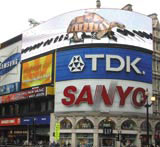Moving target
Digital advertising screens have the potential to rival billboards in the commercial landscape, but designers will have to stretch themselves to develop content that maximises the potential of the new medium, says John Stones

Electronic landscapes like those depicted in Blade Runner have yet to materialise in this green and pleasant land, but digital screens are gradually flickering into life all around us. While the UK has somewhere to go before matching Tokyo’s Shinjuku district or Times Square in New York, companies are beginning to make hefty investments, installing large digital screens where once only posters clamoured for our attention.
Earlier this month, the first digital poster screens where installed on the escalators of London’s Tottenham Court Road Underground station. Plasma screens are being used more frequently by retailers, and Lloyds TSB, for example, is piloting interactive information screens in its branches. A couple of years ago, Coca-Cola installed a technologically advanced digital billboard on its iconic site in London’s Piccadilly Circus, and took the unusual step of appointing an advertising agency (VCCP) to create content for it.
Digital screen technology (be it LED, LCD or plasma) is not new, but its widespread application outside the home or gallery is – the art world has been alive to its creative possibilities for some time. The significant costs involved means it is set to become primarily a medium for advertising.
Given the challenges and novelty, media owners such as Clear Channel International and Viacom Outdoor (which sells the space on the London Underground, and uses digital poster technology supplied by Digital View) have had to be proactive in developing content to convince brand owners and advertising creatives who are slightly wary of the new technology.
Given five or ten seconds to grab the public’s attention, without sound, as they pass on foot, by train or by car, the screens present formidable creative challenges, while offering the possibility of standing out from the static posters.
Clear Channel International group marketing director Robert Thurner has set up an internal group to develop content for its digital outdoor sites (initially made up of a graphic designer, a Web designer and an art school graduate). Wired up to computers, the screens allow for genuine interaction with mobile phones (with an editorial delay, says Thurner, to screen out unsavoury messages) or interaction with the environment, by responding quickly to, for instance, the time of day. Apart from not being able to use sound for obvious reasons, there are restrictions. Use of live action, for instance, can be deemed to be distracting for motorists, but in pedestrian areas, the creative potential is much greater.
Steve Vranakis, creative director and partner of VCCP, compares the situation with the Internet some years ago, when people were not sure of how to use its creative potential. But he adds, ‘I would love to pretend that only a select group could do the work, but basically any decent designer should be able to do it.’ He has found that animation (for instance, of classic Coca-Cola posters) has been the most effective approach.
There is uncertainty, though, about which creatives should be creating content for the new screens. Neil Morris, senior producer at Junction-7, part of Digital View and the company responsible for creating content for the Tottenham Court Road screens, says, ‘It falls through the cracks. People are unsure about how to deal with it; nobody really knows what it is. It goes to the TV producers, who say it is not for them, then the new media lot, who also say it’s not them, before ending up with the print people, as it’s more like posters than anything else.’ However, it still falls within the traditional skill sets of television motion graphics, while offering novel possibilities, such as having content ‘fly’ through successive screens.
But in terms of creative potential, most will admit the surface has only been scratched. Daljit Singh, creative director of digital design specialist Digit, is enthusiastic about the ‘tremendous opportunities’ the screens present. ‘We can apply what we have learnt on the Internet and introduce interactivity,’ he explains. ‘The screens create opportunities to change what is seen in seconds, depending on the weather, or stock market and so on, to create extraordinarily complex environments.’
He suggests it would be interesting to see what happens when the screens are given their full potential in environmental graphics, drawing on the effectiveness of LED motorway signs, and when architects begin to integrate the screens into their building designs.
But to get the most creative input, Singh suggests that media owners should be going out and directly approaching the design community as well as advertisers, if the level of creative achievement is to match what is seen in places such as Tokyo.
Although as Morris says, ‘It is a new medium, and we need to learn how the communication is going to happen. The rulebook hasn’t been written yet.’
The challenge is on for designers to harness the potential of the digital screens, to make them a part of our everyday landscape and produce work that is genuinely interesting, visually engaging and innovative. Otherwise, instead of Ridley Scott’s exciting and futuristic cyberpunk vision, the screens will simply add another layer to the banal background din of ever more pervasive advertising.
-
Post a comment




